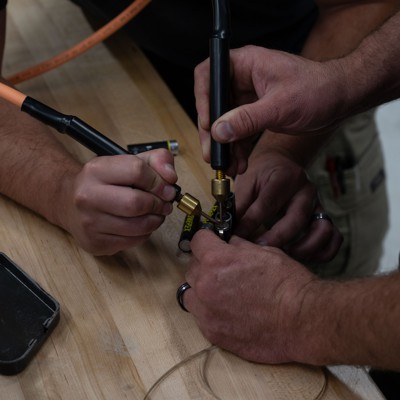Military use of drones for air, land, and sea is booming—and so is the need to power them. So the Pentagon is working on a strategy for how it sources and buys batteries—including the critical minerals they require—which officials expect to release in 2026.
This strategy will be an update to a lithium ion battery strategy published in 2023 “that laid out the groundwork for how we were going to address battery challenges in the department,” including working with other government agencies, allies and partners, Eric Shields, the senior battery advisor in the Pentagon’s industrial base policy office, told reporters Friday.
Congress mandated a department-wide battery strategy in the 2025 annual defense policy bill. The goal is to have the new strategy signed by March 2026.
“What we know is, especially from the battlefield in Ukraine, that batteries are really important. They’re important for enabling capabilities like drones, communications, and many other things that we need to fight and win. It’s important for the department to have secure supply chains for these and…really important that we have standards, because that’s one way that we’re going to tackle some of these challenges,” Shields said. “And you can see clearly in executive orders coming down on drone dominance and security, you can see guidance coming down on the importance of critical minerals to the administration that these are priorities and are going to need resources to make progress.”
The Pentagon’s reliance on critical minerals, including those required for batteries, has long been a concern, especially because much of the supply chain resides in China.
Nearly 80 percent of the Defense Department’s weapons systems rely on critical minerals, according to a recent Govini report. And that demand is only increasing as the White House and Pentagon push new technologies, such as drones, across all warfighting domains.
“We need these batteries yesterday. I need way more energy and power available in all of my platforms than what I’ve been fielding to date. And and the more I can get out there, the better off we’re going to be,” said Daphne Fuentevilla, the Navy’s deputy director for operational energy.
Friday, the Army, Navy, and Marine Corps hosted their first industry day for battery technology, with a focus on standardizing and improving supply chains and stockpiles.
“This was really the first time we sat down and collectively hosted an event with a specific purpose of bringing industry into the discussion as an equal partner,” said Marnie Bailey, the senior scientific technical manager for power and energy at the Army’s Command, Control, Communications, Computers, Cyber, Intelligence, Surveillance and Reconnaissance Center.
“Technology is moving fast. The Army is moving fast, the Navy is moving fast, DOD is moving fast. And so this industry day was the beginning of this conversation, this open dialogue with industry, so we can move fast together.”
Standardizing batteries from all angles, including cell material and modular architecture, is a primary focus, since different platforms and devices have different batteries.
“One of the things that that we’re looking looking at standardization for is: if we have to engage in conflict today—and we’re not going to have a lot of time to do a lot of the assessments and and review every single individual piece of equipment for the next two years before we field something—we’re going to be taking some risk. And the more we can provide this upfront guidance on standardization, the better off we’re going to be when we do have to actually be in a conflict,” Fuentevilla said. “Areas where we’re looking at future standardization: the small UAS space, our undersea architectures…large format batteries embedded into our ships, is also going to be a challenge.”
Making sure there’s a robust, secure, and domestic supply chain that can keep up with demand is also another priority.
“Some of this technology evolution within batteries has really enabled us to get after more capable defense weapon systems and platforms. And we have to be able to keep up with that in order to address our mission,” Fuentevilla said. “Specifically, we need batteries in our destroyers and frigates on the surface side. I need more capable sensors and weapons on our surface platforms. I also need small unmanned aerial systems, and these one-way attack drones. Because for these systems in particular, the capability that I can deliver is directly proportional to the amount of energy and battery energy that I can put on those systems.”
The Navy is also investing heavily in uncrewed surface and undersea vehicles that require battery power. And the Army and Marine Corps rely on battery-powered equipment for mobile equipment, aerial and ground vehicles—a challenge the Defense Innovation Unit has been working on.
One key takeaway from the inaugural event was that companies want to know when and what the Pentagon wanted to buy. Shields said the money is there, but the requirements are still en route.
“With the significant resourcing the department just received through the one big, beautiful bill, a lot of those decisions are still being made… stand by is kind of the message, because the requirements are coming, but we don’t have them just yet.”
On Thursday, the Energy Department proposed $1 billion in an effort to shore up the critical minerals supply chain. Earlier this year, a White House issued an executive order calling for an increase in critical minerals production, and the recently passed budget reconciliation carves out $1 billion in appropriations for Defense Production Act, which has previously been used to produce critical minerals.
The bill also includes $2 billion to improve critical minerals stockpiles and supply chains “through the National Defense Stockpile Transaction Fund” run by the Defense Logistics Agency, plus $5 billion for “investments in critical minerals supply chains” for fiscal year 2025.
Read the full article here








Leave a Reply